
Mitsubishi Lancer Owners Manual
To turn from “ACC” to “LOCK”Locking and unlocking / Keyless operation system / To turn from “ACC” to “LOCK”
1. [Vehicles equipped with M/T]
Push the emergency key in at the “ACC” position and keep it depressed until it is turned to the “LOCK” position, and remove it.
[Vehicles equipped with CVT or Twin Clutch SST]
First, set the selector lever (CVT) or the gearshift lever (Twin Clutch SST) to the “P” (PARK) position, and then push the emergency key in at the “ACC” position and keep it depressed until it is turned to the “LOCK” position, and remove.
2. Install the cover of the ignition switch.
3. Reinsert the emergency key into the keyless operation key.
![]() Note
Note
► Vehicles equipped with CVT or Twin Clutch SST, the emergency key cannot be removed unless the selector lever (CVT) or the gearshift lever (Twin Clutch SST) is set to the “P” (PARK) position.
► When not using the emergency key, always install the ignition switch cover. Otherwise, there is a danger of dirt or dust getting into the keyhole of the ignition switch and causing a malfunction.
![]()
► Do not remove the emergency key from the ignition switch while driving.
The steering wheel will be locked, causing loss of control.
► If the engine is stopped while driving, the brake servomechanism will cease to
function and braking efficiency will deteriorate.
Also, the power steering system will not function and it will require greater manual
effort to operate the steering.
► Do not leave the ignition switch in the “ON” or “ACC” position for a long time
when the engine is not running, doing so will cause the battery to be discharged.
► Do not turn the ignition switch to the “START” position when the engine is running,
doing so could damage the starter motor.
Steering wheel lock
To lock
Turn the emergency key to the “LOCK” position.
Turn the steering wheel until it is locked.
To unlock
Turn the emergency key to the “ACC” position while moving the steering wheel slightly right and left.
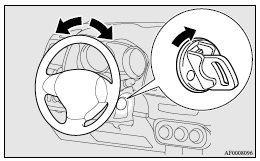
![]()
► Remove the emergency key when leaving the vehicle.
In some countries, it is prohibited to leave the key in the vehicle when parked.
Starting
Tips for starting
► Do not operate the starter motor continuously longer than 10 seconds; doing so could run down the battery. If the engine does not start, turn the ignition switch back to “LOCK”, wait a few seconds, and then try again.
Trying repeatedly with the starter motor still turning will damage the starter mechanism.
► After starting the engine in cold weather, drive in a way that keeps the engine speed low for the first few minutes or the bar graph of the engine coolant temperature display starts to move. Otherwise the engine operation may not rev smoothly and the vehicle could jerk or surge while driving.
A longer warm up period will only consume extra fuel.
► [For vehicles equipped with Twin Clutch SST] The following may occur after the engine is started, but they do not indicate an abnormality.
• You may hear operational sounds of the Twin Clutch SST and you may feel vibration in the vehicle body.
• If you shift the gearshift lever into the “N” (NEUTRAL) position and depress the accelerator pedal, increases in the engine speed will be limited.
► [Diesel-powered vehicles] While the vehicle is stationary with the clutch pedal fully depressed, the engine revolutions do not rise to over 3,000 rpm in order to protect the engine even if the accelerator pedal is depressed.
![]()
► Never run the engine in a closed or poorly ventilated area any longer than is needed to move your vehicle in or out of the area. Carbon monoxide gases are odourless and can be fatal.
![]()
► Never attempt to start the engine by pushing or pulling the vehicle.
► Do not run the engine at high rpm or drive the vehicle at high speed until the
engine has had a chance to warm up.
► Release the emergency key as soon as the engine starts to avoid damaging the starter
motor.
Starting the engine (petrol-powered vehicles)
The starting procedure is as follows: 1. Fasten the seat belt.
2. Make sure the parking brake is applied.
3. Depress and hold the brake pedal.
4. Fully depress the clutch pedal. (M/T)
![]() Note
Note
► On vehicles with the Auto Stop & Go (AS&G) system, the starter will not operate unless the clutch pedal is fully depressed (Clutch interlock).
5. On vehicles equipped with M/T, place the gearshift lever in the “N” (Neutral) position.
On vehicles equipped with CVT or Twin Clutch SST, make sure the selector lever (CVT) or the gearshift lever (Twin Clutch SST) is in the “P” (PARK) position.
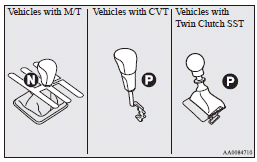
![]() Note
Note
► On vehicles with CVT, the starter will not operate unless the selector lever is in the “P” (PARK) or “N” (NEUTRAL) position.
On vehicles with Twin Clutch SST, the starter will not operate unless the gearshift lever is in the “P” (PARK) position or the gearshift lever is in the “N” (NEUTRAL) position with the brake pedal depressed.
For safety reasons, start the engine in the “P” (PARK) position so that the wheels are locked.
6. While pushing the lock release button (A), remove the cover of the ignition switch.
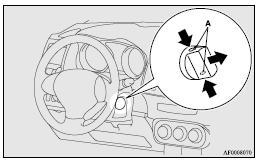
7. Insert the emergency key into the ignition switch.
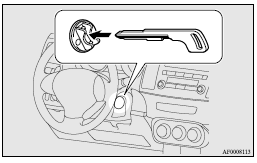
8. Insert the keyless operation key into the emergency key.
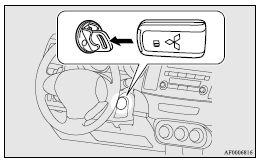
9. After turning the emergency key with the keyless operation key to the “ON”
position, make sure that all warning lamps are functioning properly before starting
the engine.
10. Turn the emergency key with the keyless operation key to the “START” position
without depressing the accelerator pedal, and release it when the engine starts.
![]() Note
Note
► Minor noises may be heard on engine startup.
These will disappear as the engine warms up.
11. Remove the keyless operation key from the emergency key.
![]()
► Make sure to remove the keyless operation key from the emergency key after
the engine is started.
If not removed, the keyless operation key could fall to the floor, which could disturb
the pedal operation. Furthermore, the keyless operation key could prevent the driver’s
knee airbag (if so equipped) from inflating normally or could be propelled to cause
serious injury if the airbag inflates.
![]() Note
Note
► If the emergency key is attached to a key holder, it may become impossible to insert the keyless operation key into the emergency key, and it may prevent the engine from being started.
When using the emergency key to start the engine, first remove the key from the key ring.
Starting the engine (diesel-powered vehicles)
1. Fasten the seat belt.
2. Make sure the parking brake is applied.
3. Depress and hold the brake pedal.
4. Fully depress the clutch pedal.
![]() Note
Note
► On vehicles with the Auto Stop & Go (AS&G) system, the starter will not operate unless the clutch pedal is fully depressed (Clutch interlock).
5. Place the gearshift lever in the “N” (Neutral) position.

6. While pushing the lock release button (A), remove the cover of the ignition switch.
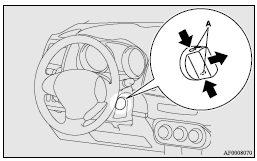
7. Insert the emergency key into the ignition switch.
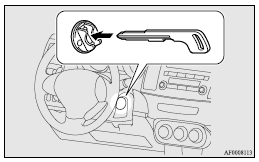
8. Insert the keyless operation key into the emergency key.
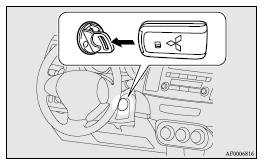
9. Turn the emergency key with keyless operation key to the “ON” position. The diesel preheat indication lamp will first illuminate, and then after a short time go out, indicating that preheating is completed.
![]() Note
Note
► If the engine is cold, the diesel preheat indication lamp is on for a longer time.
► When the engine has not been started within about 5 seconds after the diesel preheat indication lamp went out, return the ignition key to the “LOCK” position. Then, turn the emergency key to the “ON” position to preheat the engine again.
► When the engine is warm, the diesel preheat indication lamp does not come on even if the emergency key is placed in the “ON” position.
Start the engine by turning the emergency key right to the “START” position.
10. Turn the emergency key with the keyless operation key to the “START” position without depressing the accelerator pedal, and release it when the engine starts.
![]() Note
Note
► Minor noises may be heard on engine startup.
These will disappear as the engine warms up.






